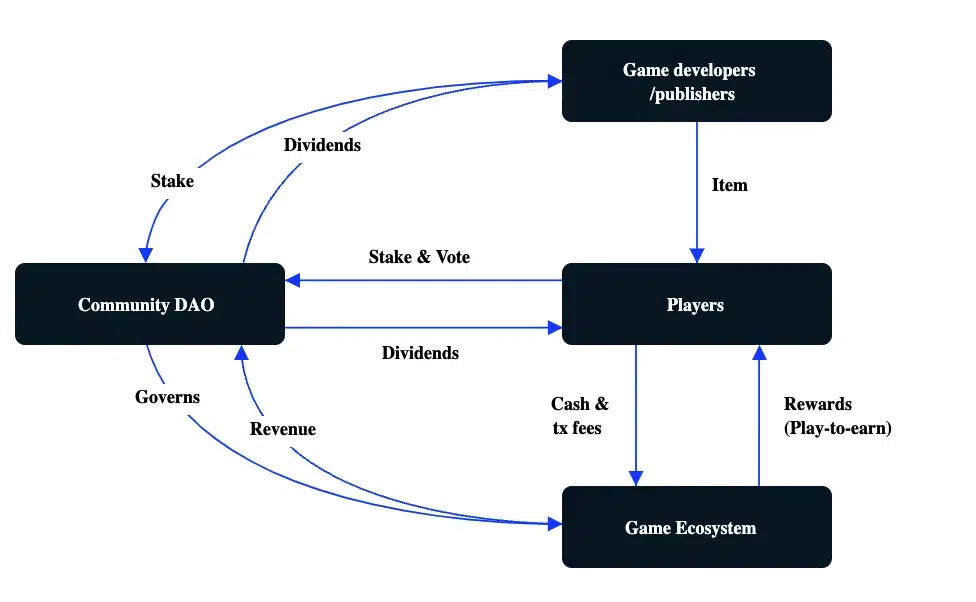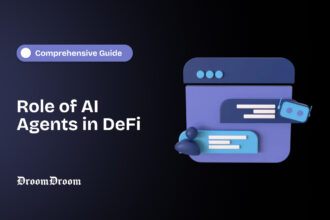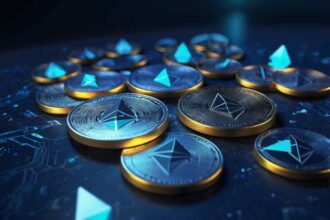The gaming industry has evolved from simple graphics to 2D, to sophisticated high definition 3D graphics, to immersive worlds and to much more. This evolution has seen a shift from gaming being a form of leisure to a completely full-time career. A career you can engage in to make money, have fun and even more pleasingly, generate passive income from your hobby.
- The 5 Components of Web 3.0 Gaming
- 8 Web 3.0 Gaming Models You Should Know
- 1. P20 or Play-to-Own
- 2. P2E or Play-to-Earn
- 3. P2P or Pay-to-Play
- 4. Learn-to-Earn (L2E)
- 5. Move-to-Earn Web 3.0 Gaming Models
- 6. Free-to-Own (F2O) Web 3.0 Gaming Models
- 7. Free-to-Play( F2P) Web 3.0 Gaming Models
- 8. X_Activity-to-Earn (X2E)
- Trends in Web 3.0 Gaming Models: Conclusion
Web 3.0 Gaming relies on five key components, content, community, digital assets, digital currency and a digital marketplace. These five components are the backbone of revenue generating Web 3.0 gaming.
Before discussing the 8 most important Web 3.0 gaming models, this article will first cover these 5 components so as to prepare your understanding of Decentralised Gaming business Models.
Thanks to new business models growing around emergent technologies, namely cryptocurrencies, DAOs, NFTs, the metaverse, tokenizaton, fractionalisation and web 3.0 communities. In this introductory guide to decentralised gaming, we will cover all Web 3.0 gaming models that have resulted from this evolution. In addition, we are going to discuss the architecture of Web 3.0 gaming and how average gamers can earn passive income using blockchain games.
The 5 Components of Web 3.0 Gaming
Content, cryptocurrencies, crypto assets, community and a crypto marketplace are the backbone of decentralised gaming. These four work synchronously to bring value across these new evolving niches.
A good analogy to explain is where manufacturers create physical products and then circulate them in the market as commodities. In Web 3.0, users create or acquire crypto assets throughout their gameplay. The crypto assets they acquire are tradable on the digital marketplace. However, one requires a cryptocurrency to buy these assets, or rather the seller receives the cryptocurrency in exchange for their assets.
The role of community in web 3.0 gaming is 1: provide the gaming ecosystem with liquid buyers and sellers of the game’s native assets. 2: foster collaboration between game developers and users to enhance feedback integration.
Content or user-generated content (UGC) is a popular concept in Web 3.0 which experts attribute for the transition from Web 1.0 to Web 2.0. While UGC first started out as a genius marketing strategy, it has become an integral part of gaming in Web 3.0.
An example of UGC in decentralised gaming is a gamer designing their own avatar wear, creating demand for this virtual wearable through their gameplay and having the option to trade it on a marketplace. This technology is not only unique to web 3.0 gaming but has grown into a vital aspect of the metaverse.
The marketplace is simply where gamers can interact and trade their in-gaming assets using a cryptocurrency as their medium of exchange.
If Temple Run or Subway Surfs had a digital marketplace where we could spend all those collectible coins or exchange our treasure boxes for a cryptocurrency; trust me the time spent playing those two games would increase immensely. However, there is a game where this is possible. Moonracers is an endless running game that aims to reprint the phenomenon that was Temple Run, however, this time on Web 3.0. This game leverages the power of Non Fungible tokens to enable gamers own and build their racing teams.
It is worth noting that the five components of Web 3.0 gaming, 4 of them are the main features of the 7th layer of the Metaverse. According to the book ‘Blockchain and the Web’ by Metaverse experts Winston Ma and Ken Huang, the metaverse has 7 main layers:
- Layer 1: Experience
- Layer 2: Discovery
- Layer 3: Creator Economy
- Layer 4: Spatial Computing
- Layer 5: Decentralisation
- Layer 6: Human Interface
- Layer 7: Infrastructure : For this seventh and final layer of the Metaverse, user-generated content, cryptocurrency, crypto assets and a crypto marketplace are evident and essential components.
8 Web 3.0 Gaming Models You Should Know
The first time I saw a 2 come infront of an O was in my biology class. P20 stands for Play-to-Own and is one of the 8 gaming models you will find in Web 3.0 games. The other Seven models include Play-to-Earn (P2E), Play-to-Play ( P2P), Learn-to-Earn (L2E), Move-to-Earn (M2E), Free-to-Own (F2O), Free-to-Play ( F2P) and X_Activity-to-Earn (X2E). We will look at each of them in the section below starting with Play-to-Own (P2O).
1. P20 or Play-to-Own
Play-to-Own (P20) is not the most popular gaming model but is a favorite among aspiring Web 3.0 gamers. There is a notion in traditional gaming that when one transitions to Web 3.0 gaming, they are looking for a platform to play and own stuff. P20 satisfies this requirement by allowing gamers to entertain themselves, collect in-game assets to probably own them, show them off to the community during events or even sell them on a marketplace.
In Play-to-Own, Non fungible tokens (NFTs) appear strongly as they are the backbone upon which the gameplay deploys in-game assets. Play-to-Own borrows the intriguing playing theatrics and gameplay mechanics of traditional gaming. In such a way that the game becomes enjoyable, features high quality titles and legitimate gameplays for driving high engagement, player interactions and vibrant communities. One would easily think Play-to-Own is similar to P2E but its not.
2. P2E or Play-to-Earn
Play-to-Earn is the most popular Web 3.0 gaming model. P2E makes it possible for players to earn income by participating in competitions and solving puzzles to earn. Thereby transforming their game time into a source of income. However, unlike Play-to-Own whose motivation is entertainment and community, P2E players have revenue as their motivation to play.

Nonetheless, this is not to say that P2E games lack engaging gameplays. In fact some Play-to-Earn games have completely immersive gameplays that could easily leave one on ‘Do Not Disturb Mode’ As the gaming industry continues to evolve, the P2E model is continuously adopting to gamers’ needs and continues to provide exciting features, more value and additional ways of motivating players.
3. P2P or Pay-to-Play
My grandfather was a professional ‘Bao’ player. Not professional in the sense that he went to school to learn Bao and became a player. Rather he was a genius Bao player __ (Bao is a game played in Traditional Africa by aged men in their 60s upwards). While the game was mostly played by these men while passing time in the evening or when having important discussions, only a few played it for money or to gamble.
My old man hated it that way and would always yell “ Stop making BAO a gamblers den’ However, he always invested in his ‘BAO’ which can loosely translate to the board on which the game was played. While the board could be built from simple wood or cardboard, his most expensive and valuable possessions were his ‘Bao’ boards. Most of which he commissioned from across cultures and from the most experienced craftsmen.
Pay-to-Play as one of the Web 3.0 gaming models would appeal to an audience as unique as my grandpa.
The model dates to as early as the 70s and is popular for bringing profits to game studios through creation of robust devices, gear and gaming products. The main focus of Pay-to-Play as one of Web 3.0 gaming models is on fun and not earnings.
However, earnings are available for professional and expert gamers. My Grandfather won many deals and many valuable friendships while playing this game, but to date he has never admitted playing as a way of generating money. His focus was on the game.
4. Learn-to-Earn (L2E)
Learn-to-Earn is a gamified method of motivating players to learn more about important features of a game, blockchain or technology. The method stands on its own as one of the disrupting Web 3.0 gaming models. While earnings are the motivation behind playing L2E games, learning is the sweet spot. These games reward players for answering specific questions about the technology, or for solving particular puzzles. Despite not being among the most popular Web 3.0 gaming models, L2E is a fun way to seek knowledge and learn more about technology.
5. Move-to-Earn Web 3.0 Gaming Models
Earlier on we mentioned MoonRacers and the global phenomenon that was Temple Run and Subway Surfers. All of these games reward users based on how they move throughout the game. The movement could be flying, running, swimming, surfing or a combination of all of them. However, it bears mentioning that Move-to-Earn is a category of Play-to-Earn but stands on its own when it comes to being a business model.
In Web 3.0, Move-to-Earn encourages players to keep moving. In 2022 alone, the M2E gaming niche surpassed a $1 billion capitalisation. However, the niche has various times come under scepticism due to several cases of exercising ponzi tokenomics. Nevertheless, the industry is still young and allows more room for speculation on what the future holds for move-to-earn games.
6. Free-to-Own (F2O) Web 3.0 Gaming Models
Free-to-Own or F20 is a revolutionary earning mechanism and one of the Web 3.0 gaming models. This model eliminates the need to invest prior to playing. For example, Axie Infinity – which is a P2E game requires players to invest atleast $1000 before starting their journey. For Axie Infinity, its either you have this minimum amount for purchasing an Axie Creature or become a scholar and play for someone else.
Free-to-Own is therefore almost similar to P2E but eliminates the need to buy any asset through either minting or purchase. Thereby allowing players to own digital assets through a game’s gameplay without the need of paying for anything. This is a rapidly evolving niche with massive room for speculation.
🎮 Embracing the Future of Gaming with Web 3.0 🚀
👾 Let's dive into how Web 3.0 is revolutionizing our beloved world of traditional gaming. 🕹️
For Gamers:
1. True Ownership 🛡️: With NFTs, own your in-game items for real! Transfer, trade, or sell them as you wish. Your loot,… https://t.co/t5ndXCHsy4
— E2NWO | Dorkslayer 🌍2️⃣ (@E2NWO) October 24, 20237. Free-to-Play( F2P) Web 3.0 Gaming Models
Free-to-Own in GameFi aims at disrupting Web 3.0 gaming by porting between Web 2.0 and Web 3.0 gaming. However, the goal is to make games that are easily accessible to day-to-day gamers. Therefore, players do not need to come with an initial investment. For instance, particular games in the traditional niche may require players to make payments so as to unlock extra levels or features. In the Free-to-Play model, such premium features are available to all users for free.
8. X_Activity-to-Earn (X2E)
X activity games are a new niche in the Web 3.0 gaming ecosystem. While they are not that popular, experts forecast the niche will contribute immensely to the gaming community. However, it is worth mentioning that the X_Activity-to-Earn (X2E) does not necessarily mean playing a game to earn. The X translates that someone has to accomplish a particular activity to continue earning. This activity could be relaxing to earn an extra crypto, sleeping or writing a blog post.
Trends in Web 3.0 Gaming Models: Conclusion
The modern game as of 2021 is not just complex graphics and bursting levels. More importantly, gaming has adopted a new economic model based on cryptocurrencies, the blockchain, non-fungible tokens and immersive storytelling.
Non-fungible tokens which are the heart of this economy are estimated to command a capitalization of $3.0 billion in 2022. Estimates have it the NFT industry will compound at an annual growth rate (CAGR) of 35% to hit $13.6 billion by 2027. One of the key factors that will drive this growth is blockchain gaming; alongside celebrity influence and the steady demand for digital artwork. A basic assumption is that as developers continue devoting more time, genius and resources to Web 3.0 games, the adoption of non-fungible tokens will continue growing.
The metaverse is another growing trend which appears significantly in Web 3.0 gaming. Already, the metaverse has converged massive influence among large corporations like Meta and NVIDIA. Alone, the metaverse industry will command annual revenues of over $400 billion by 2025.
Interoperability is another concept showing notable adoption in Web 3.0 gaming. Earlier on at the onset of blockchain gaming, interoperability issues made it difficult to use the same in-game items across multiple games. With blockchain interoperability and the rise of Layer2 chains and token bridges, it is becoming increasingly easier for players to move items from one game to another. Thereby unlocking more value on both the primary and secondary market for these collectibles.
It is evident that Web 3.0 gaming models are evolving. Not a single player wants to be left behind.
I want when the midnight train leaves, I leave with it. ‘There is this saying in crypto, going to the moon’ Who wants the rocket to take it to the moon without them?” emphasises Clifford Huborough , a professional eSports player who recently discovered the abiding pursuits of Web 3.0 gaming.
If you are a player in the space, we hope that you acquire as much knowledge as you can about blockchain gaming, the role of cryptocurrencies and how NFTs are shaping in-game ownership.




















